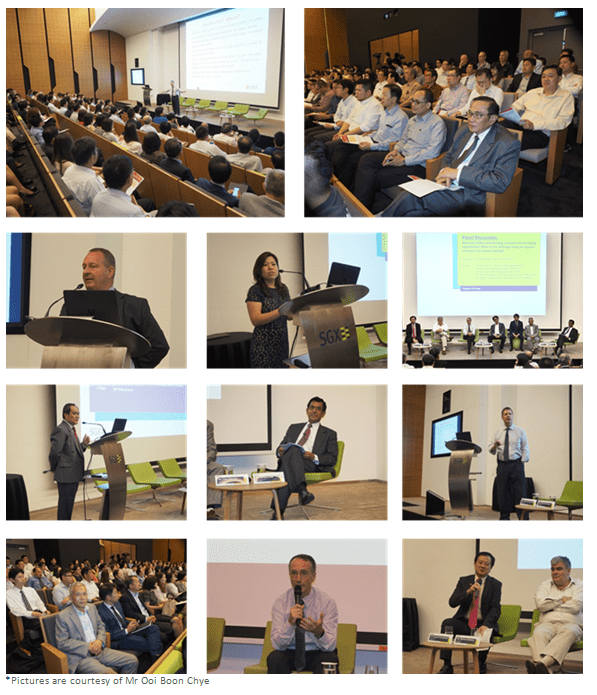More than 200 local and foreign delegates gathered in a lively forum on 26 Feb 2016 at the SGX premises to discuss the rubber industry outlook.
Discussion highlights:
-
Short term global growth is running steady-to-better, not worse. Global growth will slow going forward, and in Asia, that’s a good thing, not a bad thing. Rapid income growth is the reason behind Asia’s slower GDP growth.
-
IRSG projects global rubber demand to exceed supply in 2016 for the third consecutive year. However, the resulting draw down on stocks may not be sufficient to ease the global inventory overhang accumulated from the earlier years.
-
Driven by economic reasons, more farmers, especially those with hired labour, are switching from tapping rubber to growing other agricultural crops. That will help to rebalance the market, but production overcapacity remains a concern. Further rationalisation and consolidation in the value chain is expected.
-
Low rubber prices do not induce higher rubber demand, unlike in the case of the other commodities. Consumers simply don’t buy more cars or drive more in response to low rubber prices. Hence, so long as economic growth remains low, any price improvement in rubber will have to be supply driven.
-
The Chinese economy, which is undergoing a supply-side reform, continues to have a favourable long term outlook. Private investments will continue to promote healthy growth in the economy. Chinese enterprises are nimble and will adjust and adapt to the new paradigm. Specifically for the Chinese tyre makers, they will be able to innovate and locate opportunities in consumer segments that are under-served by the US/European tyre majors.
-
Chinese rubber demand in 2016 will likely remain stable, even with the current economic slowdown. However, there is also a view that because much of the rubber inventory overhang exists as unsold tyre stocks in China, upside demand growth for rubber in China is limited. In China’s “new normal” economy, production growth of motor vehicles is expected to slow.
-
China is reportedly regenerating/reclaiming/recycling rubber up to 4 million MT year and is likely to reduce virgin rubber demand, according to IRSG.
-
Rubber prices are governed by supply/demand, just like the other commodities, and a prolonged period of price weakness benefits no industry stakeholder in the long run. Consumers recognise that and instead prefer a stable price. To that end, tyre majors like Michelin have been providing technical assistance at farm gate level to rubber farmers.
-
There are mixed opinions on where rubber prices are headed, but with prices at a 7 year low, there is a growing optimism that chances for a rebound is high. The export cuts by Indonesia, Malaysia and Thailand starting 1 Mar 2016 could trigger a change in market sentiment.
-
The most effective way of learning to trade the rubber futures market is to actually trade it, and develop through first-hand experience an appreciation of the characteristics and nuances of the market. SICOM rubber futures are small in contract size, have sufficient liquidity and are not overly volatile, hence are suitable for most traders.
-
The regional rubber growers are mainly smallholders who are not benefiting from hedging directly in the futures market. One suggestion made was for producing nation governments to work with the smallholders and futures market operators like SICOM to manage their price risks
Click here to watch a full recording of the event.

SGX would like to thank all the speakers and panelists for sharing their insights at the event, and for the support from the Rubber Trade Associate of Singapore, The Indonesia Rubber Association (Gapkindo), The Malaysia Rubber Board, The Thai Rubber Association and The Vietnam Rubber Association.
SICOM Rubber – Recent Performance
The new year has ushered in some cheers to the rubber market with benchmarks SICOM TSR 20 and SICOM RSS 3 rebounding from a seven year low and reaching a local high of US$1.388/kg and US$1.500/kg on 7 Mar 2016. Along with the market volatility, the combined SICOM futures daily volumes have been breaking records, reaching 6,561 lots (32,805 MT) on 26 Feb 2016 and 6,682 lots (33,410 MT) on 10 Mar 2016. The increasing volume on SICOM enhances price discovery and better serves the hedging and trading needs of the marketplace.
For further details on SGX SICOM Rubber products, please contact our team or visit sgx.com/rubber
Patrick Yeo at [email protected] or (65) 6236 5371
Nicolas Wang at [email protected] or (65) 6713 7573
Tan Tee Yong at [email protected] or (65) 6713 6878




























